黄埔军校演示文稿资料
- 格式:ppt
- 大小:1.23 MB
- 文档页数:27
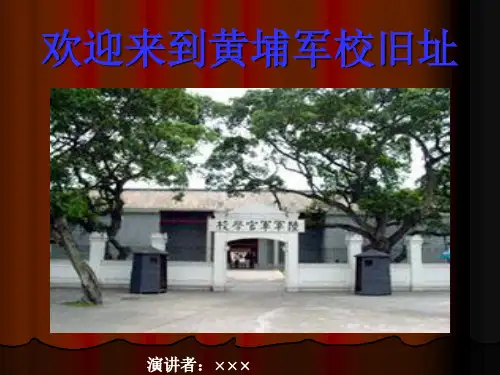
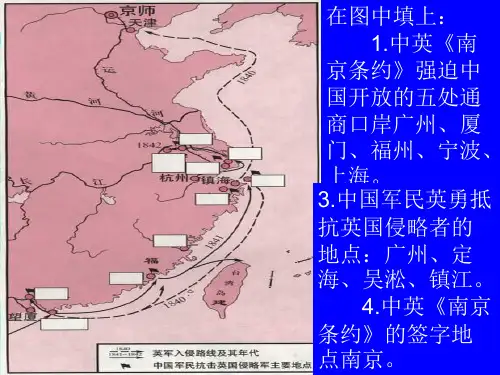

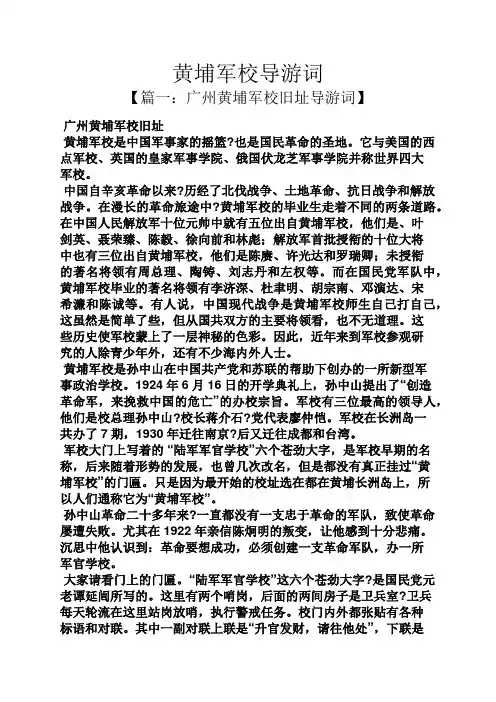
黄埔军校导游词【篇一:广州黄埔军校旧址导游词】广州黄埔军校旧址黄埔军校是中国军事家的摇篮?也是国民革命的圣地。
它与美国的西点军校、英国的皇家军事学院、俄国伏龙芝军事学院并称世界四大军校。
中国自辛亥革命以来?历经了北伐战争、土地革命、抗日战争和解放战争。
在漫长的革命旅途中?黄埔军校的毕业生走着不同的两条道路。
在中国人民解放军十位元帅中就有五位出自黄埔军校,他们是、叶剑英、聂荣臻、陈毅、徐向前和林彪;解放军首批授衔的十位大将中也有三位出自黄埔军校,他们是陈赓、许光达和罗瑞卿;未授衔的著名将领有周总理、陶铸、刘志丹和左权等。
而在国民党军队中,黄埔军校毕业的著名将领有李济深、杜聿明、胡宗南、邓演达、宋希濂和陈诚等。
有人说,中国现代战争是黄埔军校师生自己打自己,这虽然是简单了些,但从国共双方的主要将领看,也不无道理。
这些历史使军校蒙上了一层神秘的色彩。
因此,近年来到军校参观研究的人除青少年外,还有不少海内外人士。
黄埔军校是孙中山在中国共产党和苏联的帮助下创办的一所新型军事政治学校。
1924年6月16日的开学典礼上,孙中山提出了“创造革命军,来挽救中国的危亡”的办校宗旨。
军校有三位最高的领导人,他们是校总理孙中山?校长蒋介石?党代表廖仲恺。
军校在长洲岛一共办了7期,1930年迁往南京?后又迁往成都和台湾。
军校大门上写着的“陆军军官学校”六个苍劲大字,是军校早期的名称,后来随着形势的发展,也曾几次改名,但是都没有真正挂过“黄埔军校”的门匾。
只是因为最开始的校址选在都在黄埔长洲岛上,所以人们通称它为“黄埔军校”。
孙中山革命二十多年来?一直都没有一支忠于革命的军队,致使革命屡遭失败。
尤其在1922年亲信陈炯明的叛变,让他感到十分悲痛。
沉思中他认识到:革命要想成功,必须创建一支革命军队,办一所军官学校。
大家请看门上的门匾。
“陆军军官学校”这六个苍劲大字?是国民党元老谭延闿所写的。
这里有两个哨岗,后面的两间房子是卫兵室?卫兵每天轮流在这里站岗放哨,执行警戒任务。
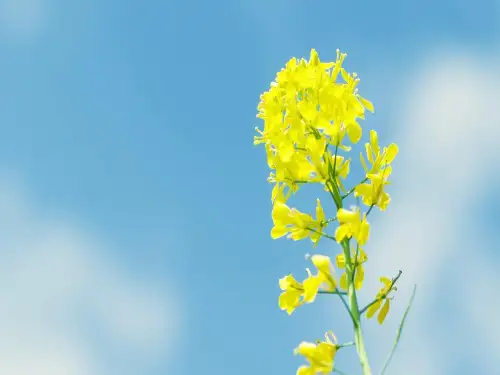
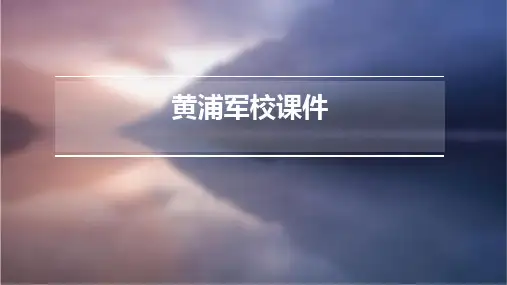
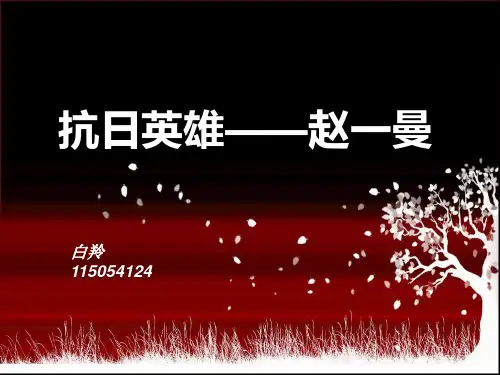
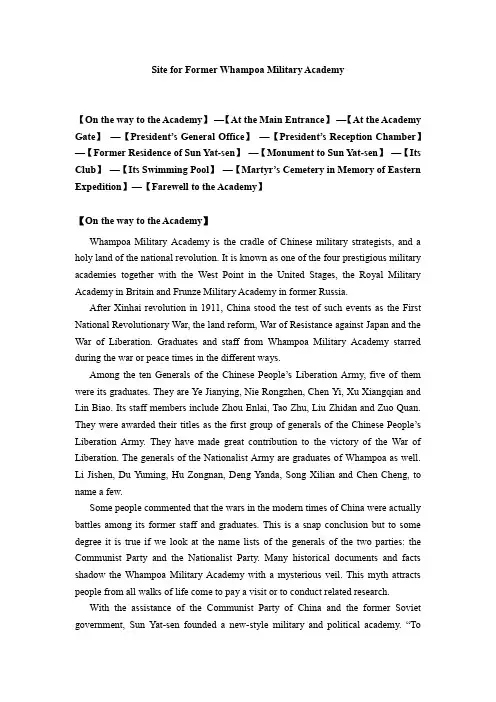
Site for Former Whampoa Military Academy【On the way to the Academy】—【At the Main Entrance】—【At the Academy Gate】—【President’s General Office】—【President’s Reception Chamber】—【Former Residence of Sun Yat-sen】—【Monument to Sun Yat-sen】—【Its Club】—【Its Swimming Pool】—【Martyr’s Cemetery in Memory of Eastern Expedition】—【Farewell to the Academy】【On the way to the Academy】Whampoa Military Academy is the cradle of Chinese military strategists, and a holy land of the national revolution. It is known as one of the four prestigious military academies together with the West Point in the United Stages, the Royal Military Academy in Britain and Frunze Military Academy in former Russia.After Xinhai revolution in 1911, China stood the test of such events as the First National Revolutionary War, the land reform, War of Resistance against Japan and the War of Liberation. Graduates and staff from Whampoa Military Academy starred during the war or peace times in the different ways.Among the ten Generals of the Chinese People’s Liberation Army, five of them were its graduates. They are Ye Jianying, Nie Rongzhen, Chen Yi, Xu Xiangqian and Lin Biao. Its staff members include Zhou Enlai, Tao Zhu, Liu Zhidan and Zuo Quan. They were awarded their titles as the first group of generals of the Chinese People’s Liberation Army. They have made great contribution to the victory of the War of Liberation. The generals of the Nationalist Army are graduates of Whampoa as well. Li Jishen, Du Yuming, Hu Zongnan, Deng Yanda, Song Xilian and Chen Cheng, to name a few.Some people commented that the wars in the modern times of China were actually battles among its former staff and graduates. This is a snap conclusion but to some degree it is true if we look at the name lists of the generals of the two parties: the Communist Party and the Nationalist Party. Many historical documents and facts shadow the Whampoa Military Academy with a mysterious veil. This myth attracts people from all walks of life come to pay a visit or to conduct related research.With the assistance of the Communist Party of China and the former Soviet government, Sun Yat-sen founded a new-style military and political academy. “Toestablish a revolutionary army to save China from all risks” was the aim he brought forth at its opening ceremony on June, 16th, 1926. This academy was under the leadership of Premier Sun Yat-sen, President Chiang Kai-shek and the Communist Party representative Liao Zhongkai. It ran seven enrollments on end before it was relocated to Nanjing in 1930 and later to Chengdu and Taiwan.【At the Main Entrance】Inscribed on the plaque at the top of the main entrance are six Chinese characters “陆军军官学校” (General Academy of Army ), written by Tan Yankai, the patriarch of the Nationalist Party. The academy was renamed for a few times, but they never put the four Chinese character “黄埔军校” on the plaque. It is called so just because it was located at Whampoa, in Changzhou Island, Guangzhou.Now we come back to the topic why Sun Yat-sen wanted to found a military academy?He devoted himself to the national revolution for more than two decades, but he did not have an army loyal to the revolution. This led to the failure in revolution from time to time, he concluded. He felt extremely sad in 1922 when Chen Jiongmin betrayed him and bombarded the Office of the President. After deep reflection, he was determined to establish a general academy of army to cultivate leading generals and well-trained soldiers in order to succeed in the revolution.Mottos and couplets were posted inside and outside the Academy. We can find the last words of Premier Sun Yat-sen here: “The work of revolution is not yet done, let all our comrades strive for its success.”Behind the main entrance is the site of the academy. It used to be the Canton Army Primary School in the late Qing Dynasty. After the Academy was established, the president’s office, departments’ offices, classrooms, dormitories and the dining hall were all here. But all the buildings on the campus were destroyed by Japanese fighter planes in 1938. It was really a pity. In May, 1998, Guangzhou municipal government decided to have the academy rebuilt. Its reconstruction cost more than 20 million yuan. It was completed on November 12th, in 1998 when it was the 130th anniversary of Premier Sun Yat-sen.【At the Academy Gate】The Academy covers an area of 10,600 square meters. Its two-storey school board buildings are brick-timber framed. Three main passages and four rows of housingbuildings are its layout.The four rows of housing buildings have the same design and stand symmetrically on either the east or the west side of an invisible north-south axis. Surrounded by walls, these four buildings lead onto the main passages. As we can see, the buildings on the campus are linked into a complete whole by passages. We can also feel its quietness and grace.The place we are now standing at was called “Dahua Hall”. It was the meeting place of its staff members and students when the academy was just set up and they did not have an auditorium.【At the Office of the Political Department】We are now visiting the office of the Political Department. Premier Zhou Enlai worked as the third director of this Department when they had their first enrollment. Marshal Nie Rongzhen acted as secretary for this Department, and he worked as a drill master as well.President’s Chamber is the room where President Qiang Kai-shek used to work and rest. The furnishings in the room are displayed according to their original arrangement when he was here. On the walls is the name list of their first enrolled students, including their name, birth place, ages and comment column. President is the person who makes the comment in the column. He once wrote about Chen Gen like this: “This graduate looks weak, but he is poised and hardworking. He is qualified to lead his men. ” From the comments he made, we could infer that President Qiang Kai Shek is a careful observer of the students’ personality, ability and strong points.【President’s General Office】Now we are entering President’s General Office. Nationalist Party’s representative, Liao Zhongkai, worked here. As the Party’s patriarch and great contributor to the Xinhai Revolution, he dedicated himself to the establishment of the Academy by taking concurrent posts. When the school had financial difficulties, he spared no effort to raise funds to get through. He assured his colleagues, “Please don’t worry about our financial situation, I’ll be responsible for it. You are shouldered with the responsibility to train and nurture our students.” His devotedness won him the title “a motherly affectionate leader of the party and the army”.【President’s Reception Chamber】The couplet in the President’s Reception says, “Climb the hills to see the sea afar, ride on the horse to pacify China”. It was written by the famous calligrapher and the Nationalist Party’s patriarch Yu Youren and was presented to President Chiang Kai-shek. The structure of the couplet in Chinese is symmetrical. Its wording is vigorous. This couplet expresses the ambition and firm determination of the staff and students to reunify China, with this academy as their solid base.【The Former Residence of Sun Yat-sen】The two-storey building combines the Chinese and western architectural styles. It was used as a customs house during the Qing Dynasty. In 1952 when this building was under repair, the wooden staircase in the west was made indoors. The exhibits were organized into the themes of “The Old Days of this Storied Building” and “Anecdotes of Sun-Mei”. We can see some pictures, and some physical objects. From the exhibits here, we can know more about the past glory of the academy, and the friendship between Sun Yat-sen and his Japanese friend, Umeya Shakichi.【Monument to Sun Yat-sen】This monument was built in 1928 and completed in 1930. It can be said that its shape and design is distinctive. Viewed from afar, a huge Chinese character “文” is eye-catching. “文” is the focus of the whole thing. Why so? As you know, “文” is the name given by his parents when he was born.The base of the monument is massive. Four striking Chinese characters “亲爱精诚” are written there, emphasizing the qualities of “love and sincerity”. This four-word text is the motto of the Military Academy. This base consists of two parts, separating by a passage. The lower part implies a figure of seven. It symbolizes the seven enrollments the Military Academy has had in Whampoa. The upper part implies a figure of five. It refers to the five battles its staff and students waged successfully.Please look up at the statue of Sun Yat-sen. He was concentrating himself in lecturing his Three Principles of the People, wasn’t he?This bronze statue is 3.9 meters in height and 1 ton in weight. It was donated by his Japanese friend, Umeya Shakichi, who entrusted this work to a Japanese sculptor (牧田祥哉). As Umeya was in financial difficulty at that time, he had four identical statues made only. The other three were placed respectively in Sun Yat-sen Universityin Guangzhou, Sun Yat-sen Mausoleum in Nanjing, and Sun Yat-sen Memorial in Macau.Under the foot of the statue, we can see Chinese characters inscribed on the four sides of the monument. On its front façade is “孙总理纪念碑” , the handwritings of a famous calligrapher, called Hu Hanming. Its equivalent in English is “Dedicated to Premier Sun”. On its back are the words, depicting him a man as he is. These words are used as the oaths of his comrades when they go on with the work he left unfinished. On its eastern side are “和平、奋斗、救中国” (For Peace, to Struggle and Save China). On its western side is the exhortation of Premier Sun. These words have been encouraging, inciting and advising earnestly his comrades and later generations. His exhortation was adopted as national anthem after Nationalist Party settled its capital in Nanjing 1927.【Its Club】This two-storey building, quite a grand hall at that time, was completed in 1926. It holds more than one thousand people. The Academy often had their gatherings, presentations, celebrations, and entertaining performance here in this auditorium.【Its Swimming Pool】Most of the students were from the northern part of China. They couldn’t swim. This could be a drawback. Two docks nearby were transformed into swimming pools. They first learned how to swim in the pools, then went to swim in the Pearl River. This training prepared the enrolled students to fight in the southern part of China where water networks were formed.【Martyr’s Cemetery in Memory of Eastern Expedition】This cemetery was built in 1925, completed one year later. Its design is similar to Cemetery for 72 martyrs at Huanghuagang, Guangzhou.This cemetery was built in memory of 516 martyrs who lay down their life on the two Eastern Expeditions in 1925. Among those heroes, Liu Yaozhan was of the highest rank. He was promoted to Lieutenant General after his death.On its west lies the cemetery for their 16 generals. Inscribed there are the nine Chinese characters read like “东征阵亡烈士纪念坊”. Its equivalent of English is “Dedicated to the Martyrs on Eastern Expeditions”. They are the handwritings ofZhang Renjie. His other name is Zhang Jingjiang. He is the patriarch of the Nationalist Party, the military counselor and the teacher of Chiang Kai-shek. He was one of the three most famous calligraphers serving for the Nationalist Party.Eastward Walk brings us to the cemetery of Cai Guangju. Born in Zunyi, Guizhou, he was a student in the list of the first enrollment of the Academy. On the Eastern Expedition, he died in Danshui. Due to his bravery and his high ranking among the graduates, he earned this honour to have his own cemetery.Monument to the Northern Expedition was erected in 1929 to remember those who sacrificed their life in the battles on their Northern Expedition. It is 7 meters high. There are inscriptions on the three sides of the base. “Dedicated to the Graduates of the General Academy of Army who served as Generals and Lieutenants, but sacrificed on the Northern Expedition” are the characters written on its front façade. “Sacrifice for the Motherland” are on its east side while “Sacrifice for the People” are on its west. The names of 353 martyrs who were graduates of the Academy are inscribed on the northern, eastern and western sides.Their noble spirit of revolution are unceasingly inspiring later generations.。
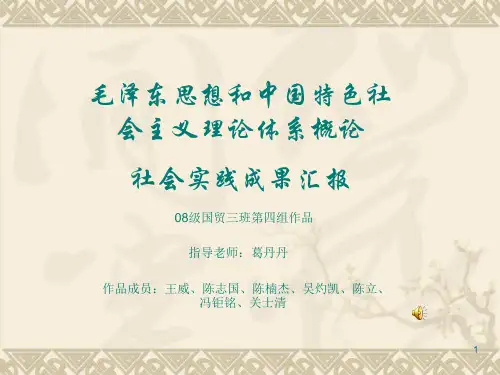

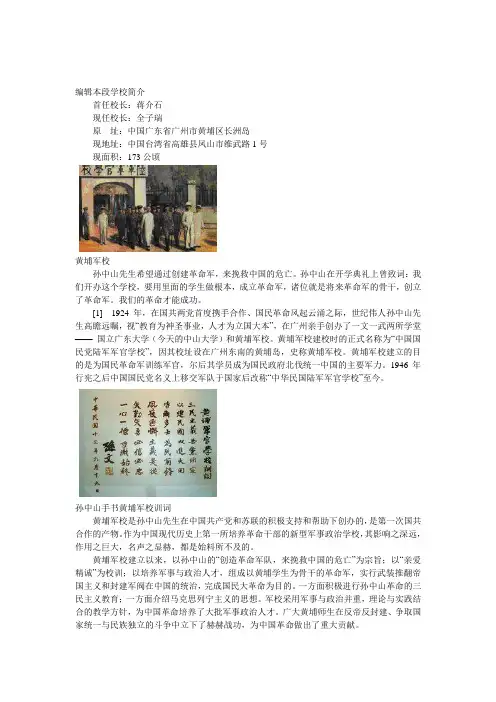
编辑本段学校简介首任校长:蒋介石现任校长:全子瑞原址:中国广东省广州市黄埔区长洲岛现地址:中国台湾省高雄县凤山市维武路1号现面积:173公顷黄埔军校孙中山先生希望通过创建革命军,来挽救中国的危亡。
孙中山在开学典礼上曾致词:我们开办这个学校,要用里面的学生做根本,成立革命军,诸位就是将来革命军的骨干,创立了革命军。
我们的革命才能成功。
[1]1924 年,在国共两党首度携手合作、国民革命风起云涌之际,世纪伟人孙中山先生高瞻远瞩,视“教育为神圣事业,人才为立国大本”,在广州亲手创办了一文一武两所学堂——国立广东大学(今天的中山大学)和黄埔军校。
黄埔军校建校时的正式名称为“中国国民党陆军军官学校”,因其校址设在广州东南的黄埔岛,史称黄埔军校。
黄埔军校建立的目的是为国民革命军训练军官,尔后其学员成为国民政府北伐统一中国的主要军力。
1946年行宪之后中国国民党名义上移交军队于国家后改称“中华民国陆军军官学校”至今。
孙中山手书黄埔军校训词黄埔军校是孙中山先生在中国共产党和苏联的积极支持和帮助下创办的,是第一次国共合作的产物。
作为中国现代历史上第一所培养革命干部的新型军事政治学校,其影响之深远,作用之巨大,名声之显赫,都是始料所不及的。
黄埔军校建立以来,以孙中山的“创造革命军队,来挽救中国的危亡”为宗旨;以“亲爱精诚”为校训;以培养军事与政治人才,组成以黄埔学生为骨干的革命军,实行武装推翻帝国主义和封建军阀在中国的统治,完成国民大革命为目的。
一方面积极进行孙中山革命的三民主义教育;一方面介绍马克思列宁主义的思想。
军校采用军事与政治并重,理论与实践结合的教学方针,为中国革命培养了大批军事政治人才。
广大黄埔师生在反帝反封建、争取国家统一与民族独立的斗争中立下了赫赫战功,为中国革命做出了重大贡献。
黄埔军校自1924年6月在广州创办到1949年底迁往台湾高雄县凤山市,在大陆共办了二十三期,在台续办至今已七十八期,在大陆时期其毕业生包括各分校、训练班在内,计有41386人。
黄埔军校讲解词校本部欢迎大家来到黄埔军校旧址纪念馆参观,今天由我为大家作总体介绍,与大家一起领略黄埔军校的风采。
我们现在所在的位置是黄埔军校校本部的大门。
正门写有“陆军军官学校”六个大字,它是黄埔军校的正式名称,但由于军校校址首选在广州黄埔长洲岛,也叫黄埔岛,所以人们习惯称之为“黄埔军校”。
“陆军军官学校”六个苍劲有力的大字是出自国民党元老,著名书法家之一谭延闿先生之手。
黄埔军校诞生在风雷激荡的19世纪20年代,是中国民主革命伟大的先行者孙中山先生在经历多次革命失败后,于1924年在中国共产党和苏联的帮助下创办的一所新型的军事政治学校。
我们都知道,世界著名军校有美国西点军校、英国桑赫斯特皇家军事学院、苏联伏龙芝军事学院等,而从人才辈出、将星闪烁的盛况看,黄埔军校可与这几所军事名校并列。
黄埔军校由孙中山任校总理,蒋中正任校长,廖仲恺任党代表。
苏联政府和共产国际对于军校的创办和教学给予了很大的支持,任命巴甫洛夫、加仑等担任军事顾问,鲍罗廷等任政治顾问,他们都是苏俄国内战争期间战功赫赫的著名将领。
苏联军事援助也一批批到来,他们认真负责的态度受到军校全体师生的尊敬,黄埔军校内洋溢着中苏友好的气氛。
军校的创办在社会上引起了很大的反响,年轻人当中都流传这么一句话:要革命,到黄埔。
到黄埔军校来学习已经成为了当时年轻人最骄傲的一种选择。
除了国内的学生,还有很多来自邻国的学生,如越南、朝鲜、新加坡就有学生在黄埔军校就读。
军校1924年至1930年期间在黄埔岛办了7期,合计潮州、武汉等分校共培养学生约3.3万名。
军校以“创造革命军来挽救中国的危亡”为宗旨,形成了以“亲爱精诚、团结合作、为国爱民、不怕牺牲”为核心的黄埔精神,锻造出一支新型的革命军队,培养出一大批国共两党的军事政治人才,曾任朝鲜民主主义人民共和国国家副主席的崔庸健也曾是黄埔军校第五期教官,他们在打倒军阀、抗击日本侵略等战争中立下了赫赫战功。
因此,黄埔军校被称为“将帅的摇篮”。